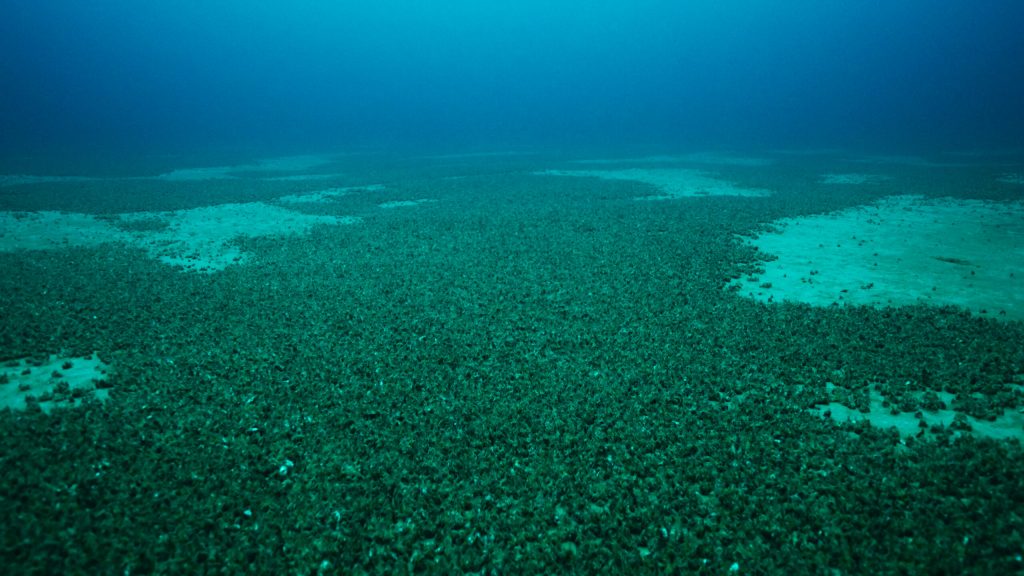Quadrillions of Invasive Mussels Damaging the Great Lakes
Documentary film's underwater drones show greatest change since the Ice Age.

Quagga mussels cover most of the lower Great Lakes, as seen in this photo. Photo courtesy Inspired Planet Productions
Yvonne Drebert and Zach Melnick love the Great Lakes. The married documentarians live on the Bruce Peninsula, which is on Lake Huron in Ontario and has similar terrain to Wisconsin’s Door Peninsula: limestone cliffs, cedar trees and lake vistas.
So, when the two learned about the massive drop in lake whitefish populations, they knew they wanted to make a film about it. Whitefish are one of the most important commercial Great Lakes fish, and they hold significance for Indigenous people of Canada and the U.S.
The resulting three-part series, “All Too Clear: Beneath the Surface of the Great Lakes,” uses cutting-edge underwater drone technology to capture life hundreds of feet below the surface of the world’s largest freshwater ecosystem, resulting in what the filmmakers believe to be the first shots of whitefish spawning in the wild.
“We wanted to bring whitefish to life,” Melnick told WPR’s “Wisconsin Today.”
Even though whitefish are an important species, people have a hard time picturing them, he added.
“If we sort of close our eyes and imagine it, we’re much more likely to imagine … tuna in the ocean than we are whitefish in the Great Lakes, even if we’re Great Lakes people,” he said. “So, we really wanted to use the underwater drone technology to take us into the world of the lake whitefish and film as much of their life cycle as we could.”
Since the late 1990s, the lake whitefish population has declined as much as 80 percent in parts of the Great Lakes. The culprit is a tiny invasive species called the quagga mussel, a close relative of the infamous zebra mussel. Both species are native to eastern Europe and traveled to the U.S. on ballast water in the 1980s.
The quagga mussel has infiltrated the lowest level of the Great Lakes’ food chain, eating tiny phytoplankton that algae need to grow — and the reverberations are felt throughout lake ecosystems. Microscopic creatures called zooplankton don’t have enough algae to eat. Small prey fish and baby fish don’t have enough zooplankton to eat. In turn, the large fish who do manage to make it to adulthood often lack adequate food.
The scale of the invasion is enormous. Not millions, not billions, but quadrillions of quagga mussels now populate all of the lower Great Lakes.

Quagga mussels blanket the depths of Georgia Bay in Lake Huron, Ontario, Canada. Photo courtesy of Inspired Planet Productions
“All Too Clear” features many shots of lakeshore bottoms carpeted with quagga mussels, with nothing else around as far as the eye can see.
There are so many mussels and they are such efficient filter feeders that fewer than every two weeks the entire volume of Lake Michigan is filtered by them, resulting in clear, blue water that’s beautiful but inhospitable for many lake species.
One of the scientists featured in the documentary is the University of Wisconsin-Milwaukee’s Harvey Bootsma, who has experimented with innovative, and at times scrappy, ways of killing quagga. That includes laying a large tarp over them and dragging what is essentially a handmade underwater bulldozer over the lake bottom.
Scientists and environmentalists across North America are working to reverse the damage done in innovative ways. The scientists featured in “All Too Clear” breed baby whitefish and let them grow strong in a pond before releasing them into the lakes, attempt to engineer a contagious blood cancer to transmit to quaggas, rebuild reefs where trout and whitefish spawn, and more.
Bootsma is “one of the people that is out there every day doing everything he can to try to figure out how we can manage these mussels to help our native species make it through this really tough time,” Drebert said.
“Africa has the Sahara, we’ve got the ice in the Arctic. We here in North America, we’ve got the Great Lakes. And it’s something that we really do need to treasure and protect the best we can,” she added.
The documentary is only available in Canada for now, with the exception of some U.S. film festivals.

Filmmakers discovered this shipwreck, the 19th-century steamship “Africa,” during filming. It is covered in quagga mussels that bore into the wood. Photo courtesy of Inspired Planet Productions
Quadrillions of invasive mussels are damaging the Great Lakes, documentary shows was originally published by Wisconsin Public Radio.
If you think stories like this are important, become a member of Urban Milwaukee and help support real, independent journalism. Plus you get some cool added benefits.





















This is incomprehensible: Quadrillion is a thousand trillion (10 to the 15th power, 10^15); Number of estimated grains of sand on planet earth is 7.5 quintillion (7.5 x 10^18). Somehow, this just doesn’t seem right.
So big fish need to eat smaller fish, which rely upon tiny fish fry which need to eat zooplankton, which depend upon algae that mutually codepend upon phytoplankton? And the tiny mussels suck up (filter!) the algae.
So how about developing a mussel harvesting industry that might contribute to fertilizer and other things requiring calcium in their shells? And some algae and phyto- and zooplankton hatcheries to restock the Lakes? And the zebra & quagga mussels– what’s their native habitats like? Are they prey for other species?
This is another important reason to support research by our fresh water scientists here in Milwaukee! Fascinating opportunities!
Our current president and his partner Sir Musk will not allow cancer research. Why do we think they would allow saving the great lakes?
mpbehar:
There is a danger in your suggestion, especially if it works.
Simpledee and Simpledumb’s retarded rampage will have a new ‘Mission Statement’ – “When life gives you muscles make MuscleAid”.
First let’s try a massive airlift.
Call it “Manna to Make Mara Lago Muscular!